TL; DR
How does Grass stand out among numerous DePIN projects?
The core factor is the no-threshold zero-cost participation; users are the cornerstone, while other factors serve as leverage.
Grass breaks through the DePIN competition with a "technology + model" dual engine — ensuring data authenticity through zero-knowledge proofs and Solana Layer2 architecture, addressing the "dirty data" pain point in the AI industry; simultaneously, it converts 2.5 million users into data nodes through a "bandwidth mining → points incentive" model, forming a supply-side crushing advantage.
Coupled with the explosive demand for AI data, the popularity of Solana and DePIN, and reasonable operational methods, it has established itself as a leader in AI data-related DePIN.
What factors should be considered for Grass's future participation?
Short-term focus on technology implementation: whether the decentralized transition can succeed by 2025;
Mid-term focus on demand validation: the scale of data procurement by AI companies;
Long-term focus on compliance dynamics: data privacy and ownership rules.
The current biggest risk lies in the "token frenzy masking the demand vacuum" — if future AI client orders do not increase, the perfect business flywheel may degrade from a positive cycle of "data-capital" to a supply-side bubble.
The report is approximately 12,000 words, with an estimated reading time of 10 minutes (This report is produced by DePINone Labs; please contact us for reprints)
1. Industry Background
When the democratization of computing power in DePIN meets the data dilemma of AI, a silent data equity movement has quietly erupted.
DePIN integrates global idle resources (computing power, storage, bandwidth) through token economics to build a distributed infrastructure network; meanwhile, the AI industry faces a structural shortage of data, with monopolies, privacy disputes, and silo barriers leading to 80% of data value being unreleased.
The future competition in AI is essentially a dual game of data acquisition efficiency and ethical compliance, and DePIN provides the optimal technical solution.
The disruptive nature of Grass lies in the realization of this integration.
1.1 DePIN: A Global Paradigm for Reconstructing Infrastructure
Definition and Core Logic
In recent years, with the maturity of blockchain technology and the rise of Web3 concepts, various industries are exploring decentralized transformation paths. DePIN is a manifestation of this trend in the infrastructure sector. DePIN (Decentralized Physical Infrastructure Networks) is a new economic model that integrates globally distributed physical resources (such as computing power, storage, bandwidth, energy, etc.) through blockchain technology.
Its core logic is: driving community contributions of idle resources through token incentives to build a decentralized infrastructure network, replacing the high-cost, low-efficiency model of traditional centralized service providers.
Industry Drivers
Compared to centralized models, the decentralized transformation of physical infrastructure has greater advantages in cost structure, governance models, network resilience, and ecological scalability.
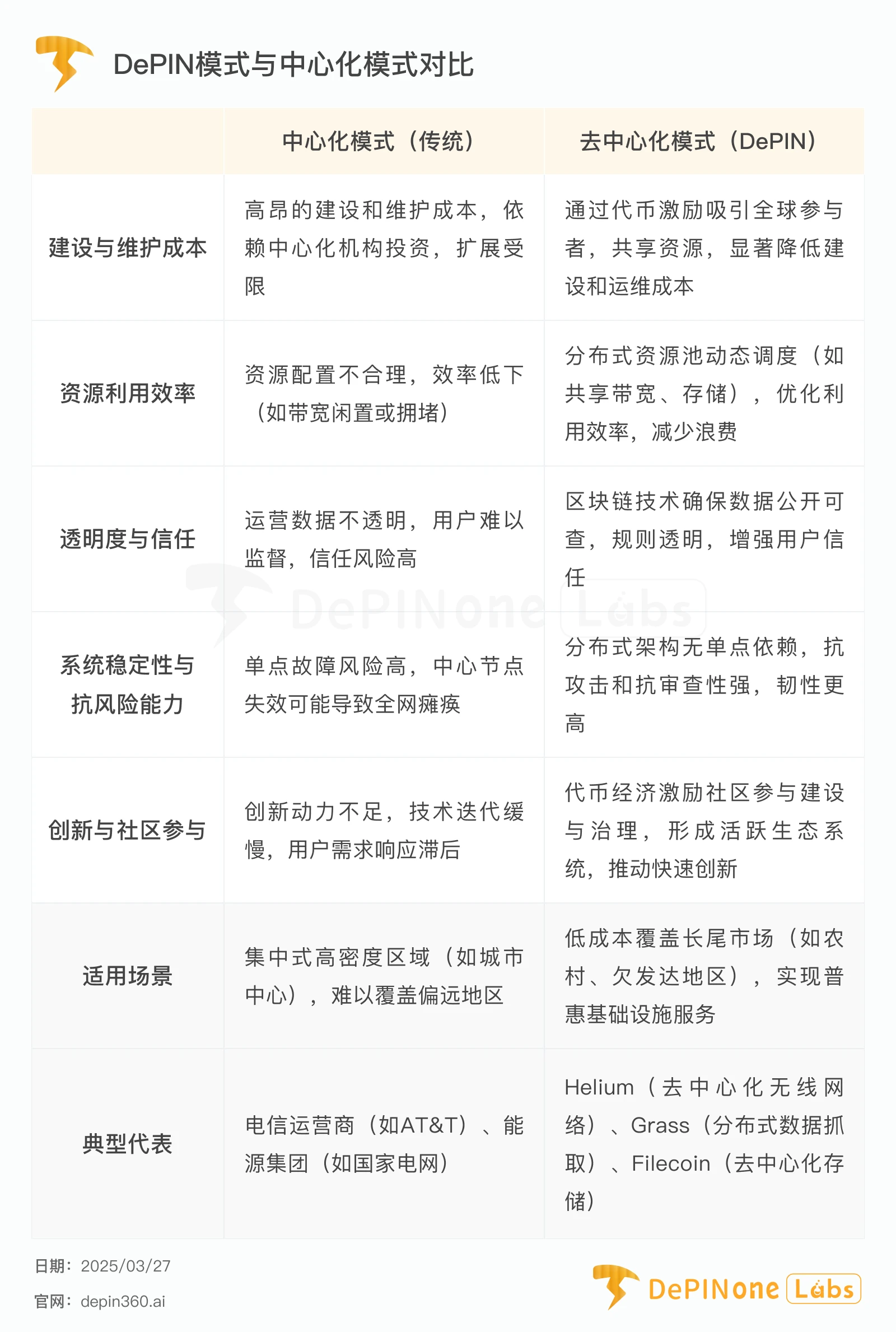
Subfields and Typical Cases
According to Messari's definition, DePIN encompasses two main categories: physical infrastructure (such as wireless networks, energy networks) and digital resource networks (such as storage, computing), achieving supply-demand matching and incentive mechanisms through blockchain technology.
Physical Infrastructure: Represented by Helium (decentralized wireless network), which builds a globally covered communication network through community-deployed hotspot devices;
Digital Resource Networks: Including Filecoin (decentralized storage), Aethir (distributed computing), etc., forming a shared economy model by integrating idle resources.
Market Potential
According to Messari data, by 2024, the number of global DePIN devices has exceeded 13 million, with a market size of $50 billion, but the penetration rate is less than 0.1%, with the potential to grow 100–1000 times in the next decade.
In 2024, the total market value of the DePIN track will reach $50 billion, covering over 350 projects, with an annual growth rate exceeding 35%.
The core driving force lies in the bilateral effects of resource efficiency improvement (such as utilizing idle bandwidth) and demand explosion (such as AI's demand for computing power and data).
Of course, the scalability of decentralized networks, data privacy, and security verification remain key challenges for DePIN's development.
1.2 AI Data Demand: Explosive Growth and Structural Contradictions
"Data is the new oil"
The acquisition and processing of AI data are the core driving forces behind the development of artificial intelligence, especially in training large language models (like GPT) and generative neural networks (like MidJourney).
The performance and effectiveness of AI models largely depend on the quality and quantity of training data. High-quality, diverse, and geographically representative data are crucial for the performance of AI models.
Scale and Characteristics of Data Demand
Magnitude leap: For example, GPT-4 requires over 45TB of text data for training, while the iteration speed of generative AI demands real-time updates and diversity in data;
Cost proportion: In AI development, the costs of data collection, cleaning, and labeling account for over 40% of the total budget, becoming a core bottleneck for commercialization;
Scenario differentiation: Autonomous driving requires high-precision sensor data, medical AI relies on privacy-compliant case databases, and social AI depends on user behavior data.
Traditional Data Supply Pain Points
Data barriers: Core enterprises/subjects control extensive data sources, while small and medium developers face high thresholds and unfair pricing;
Data silos: Data is often scattered among different institutions and enterprises, facing numerous obstacles to sharing and circulation, leading to underutilization of data resources;
Data privacy: Data collection often involves privacy and copyright disputes, such as the Reddit API charging incident that sparked developer protests;
Inefficient circulation: Data silos and lack of standardization lead to repeated collection, with global data utilization rates below 20%;
Value chain interruption: Individual contributors who create data cannot profit from the subsequent use of that data.
DePIN's Path to Breakthrough
Distributed data collection: Capturing public data (such as social media, public databases) through a node network, reducing the cost of data collection and improving the efficiency and scale of data collection;
Enhancing data quality and diversity: Through DePIN's incentive mechanisms, more participants can be attracted to contribute data, thereby improving the quality and diversity of data and enhancing the generalization ability of AI models;
Decentralized cleaning and labeling: Community collaboration completes data preprocessing, combined with zero-knowledge proofs (ZK) to ensure data authenticity;
Tokenized incentive closed loop: Data contributors receive token rewards, and demand-side parties purchase structured datasets with tokens, forming direct supply-demand matching.
The Grass project is positioned at the intersection of DePIN and the AI data industry, innovatively applying the DePIN concept to the field of AI data collection, building a decentralized data scraping network aimed at providing a more economical, efficient, and reliable data source for AI model training.
In the following chapters, we will delve into the specific mechanisms, technical characteristics, application scenarios, and future development prospects of the Grass project.

2. Project Basic Information
Grass's rapid expansion is inseparable from its extremely low participation threshold. It allows every user to become an 'miner' of AI data, exchanging idle bandwidth for future dividends.
Grass builds a decentralized data scraping network through the DePIN architecture, providing high cost-performance and high diversity data sources for AI training. Users only need to install the client to contribute bandwidth and earn token rewards — in just one year, it attracted over 2.5 million nodes, with the token's initial launch increasing over five times in ten days, validating its business logic.
The project has received backing from top capital such as Polychain and Hack VC, relying on Solana's high-performance chain to achieve data rights confirmation and circulation.
The current anonymity of the team remains controversial, and the progress of data processing decentralization needs to be followed up.
2.1 Business Scope
Grass is a DePIN project that collects and verifies internet data through the unused bandwidth of user devices, particularly supporting artificial intelligence (AI) development.
Its core is a residential proxy network that allows companies to use users' internet connections to access and scrape internet data from different geographical locations, which is very useful for AI model training that requires diverse and geographically representative data.
Problems solved: Traditional web scraping is usually done by centralized systems, which are inefficient and prone to errors or biases. Grass aims to provide reliable, verified internet data through a decentralized approach, and the data provided by decentralized users naturally possesses diversity, multi-regional distribution, and real-time characteristics.
Vision and mission: Grass's vision is to create a decentralized internet data layer where data is collected, verified, and structured in a trust-minimized manner. Its mission is to empower users to contribute to the data layer and incentivize participation through a reward mechanism.
User participation method: Users can start in three simple steps: visit the Grass official website, install the extension/client, connect, and start earning Grass Points. This method of contributing bandwidth to earn rewards provides ordinary users with an opportunity to share in the growth dividends of AI.
In summary, Grass's key features and advantages lie in: low-cost data scraping through a decentralized network, richer data diversity; users earn rewards by contributing bandwidth, realizing the return of data value; and using blockchain technology to verify data, ensuring transparency and reliability.
2.2 Development History
Concept phase: In mid-2022, the project was proposed by Wynd Labs.
Development phase: Product construction began in early 2023, marking the project's entry into the actual development stage.
Seed round financing: In 2023, Grass completed a $3.5 million seed round financing led by Polychain Capital and Tribe Capital, totaling $4.5 million (including a pre-seed round led by No Limit Holdings).
User Testing: At the end of 2023, a Chrome browser extension was launched, starting user testing and attracting early user participation.
Milestone: In April 2024, the project announced over 2 million connected node devices, which are rapidly growing. According to DePIN Scan data, as of March 2025, its active users have exceeded 2.5 million.
First Airdrop: On October 21, 2024, the first airdrop was announced, distributing 100 million GRASS tokens (10% of total supply) to reward early users.
Exchange Listing: On October 28, 2024, it was listed on exchanges such as OKX, with the price increasing from $0.6 to $3.89 in 10 days, steadily rising about 5 times.
Current Status: The project continues to expand and is conducting the second phase of user hanging incentives; plans to launch Android and iPhone mobile applications to increase network scale and user participation.
2.3 Team Situation
According to Rootdata, Grass was developed by Wynd Labs, founded by Andrej Radonjic, who is the CEO of Wynd Labs, holding a master's degree in Mathematics and Statistics from York University and a bachelor's degree in Engineering Physics from McMaster University.
All team members come from Wynd Labs, focusing on blockchain and AI technology development, with relevant field experience. However, specific member information has not been widely disclosed, with only Radonjic's identity being revealed.
According to Tracxn, Wynd Labs was established in 2022, with Grass as its core product.
The team's background demonstrates expertise in the blockchain and AI fields, but the lack of information transparency may affect investor and user trust. Radonjic's experience lends credibility to the project, but the anonymity of other members may raise concerns.
2.4 Financing and Important Partners
Investors and Support
Seed Round: In 2023, a $3.5 million seed round was completed, led by Polychain Capital and Tribe Capital. According to Rootdata, total financing after the seed round reached $4.5 million, including a pre-seed round led by No Limit Holdings.
Series A Financing: In September 2024, Series A financing was completed, led by HackVC, with participation from Polychain, Delphi, Lattice, and Brevan Howard, with the amount undisclosed.
Investor Support: HackVC, Polychain, Delphi, Lattice, and Brevan Howard are well-known investors in the industry. Gaining their support also indicates the project's recognition within the industry.
Partners
Blockchain Platform: Built on the Solana network, the project leverages Solana's high performance and scalability.
Currently, there are no specific collaborations mentioned with AI companies or other projects, but the Solana network's ecosystem may provide opportunities for future partnerships.
3. Project Technical Analysis
Grass attempts to redistribute data value from large tech companies back to ordinary users.
The node network, ZKP processing innovations, and data ledger in Grass's technical architecture form a closed-loop workflow, decentralizing the entire chain from collection, verification to delivery, effectively supporting its decentralized vision.
However, current centralized operations need to be addressed, and the smooth implementation of technology still needs to be tracked.
3.1 Core Technical Architecture: Sovereign Data Rollup
Grass is building the first sovereign data rollup. It simplifies data procurement and transformation through a globally distributed Grass node network, enabling AI access to structured web data. The infrastructure is supported by a dedicated data rollup on Solana, designed to manage the complete lifecycle of data — sourcing, processing, verification, and dataset construction. The architecture revolves around the following components:
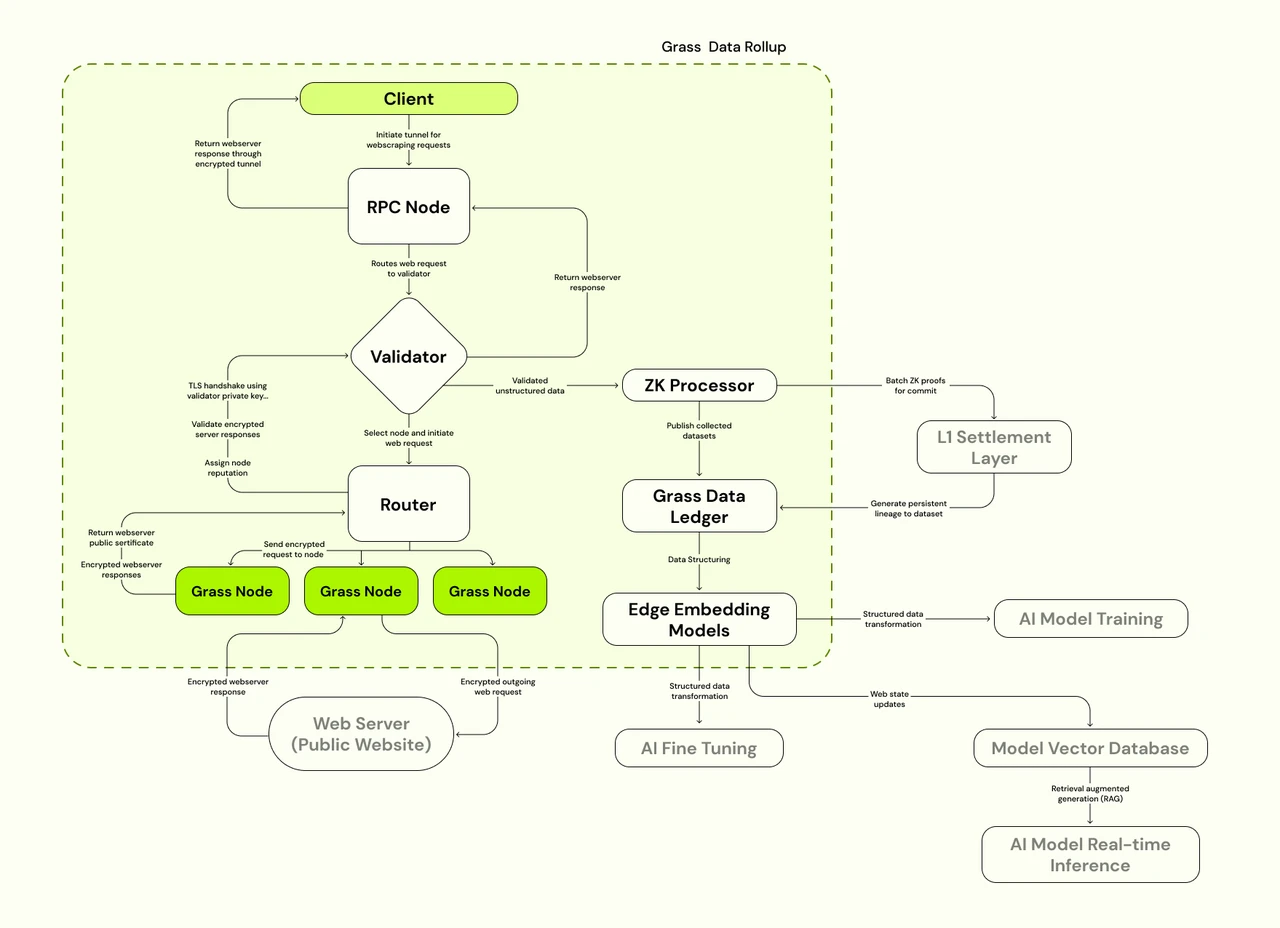
Breaking down the core components of Grass's technical architecture:
Node Network
Composed of three layers: validators, routers, and Grass nodes.
Users share unused internet bandwidth by installing a browser extension/desktop application, forming individual Grass nodes that collectively create a globally distributed network. Currently, Grass has over 2.5 million nodes, covering over 190 countries, scraping about 100TB of data daily, providing diverse and geographically representative data sources for AI development.
Grass routers connect Grass nodes to validators. Routers manage the node network and relay bandwidth.
Validators receive, verify, and batch process transactions distributed by routers. They then generate ZK proofs to check session data on-chain. In the current phase, data collection is handled by centralized systems, with plans to achieve decentralization through Layer 2 networks in the future.
Zero-Knowledge Proof (ZK) Processor
- Grass uses zero-knowledge proofs to verify data sources, ensuring data privacy and integrity. The ZK processor generates on-chain proofs, verifying data sources and tracking their lifecycle, enhancing data credibility. As Donovan Choy stated, the application of ZKP addresses the trust issues of traditional web scraping, providing transparency for the AI data market.
Data Ledger
- The Grass Data Ledger links the scraped data with the L1 settlement layer. Data is recorded on the blockchain through Grass's Layer 2 network (based on Solana), forming the "Sovereign Data Rollup." This ensures data transparency and traceability, supporting AI developers' efficient access to structured datasets.
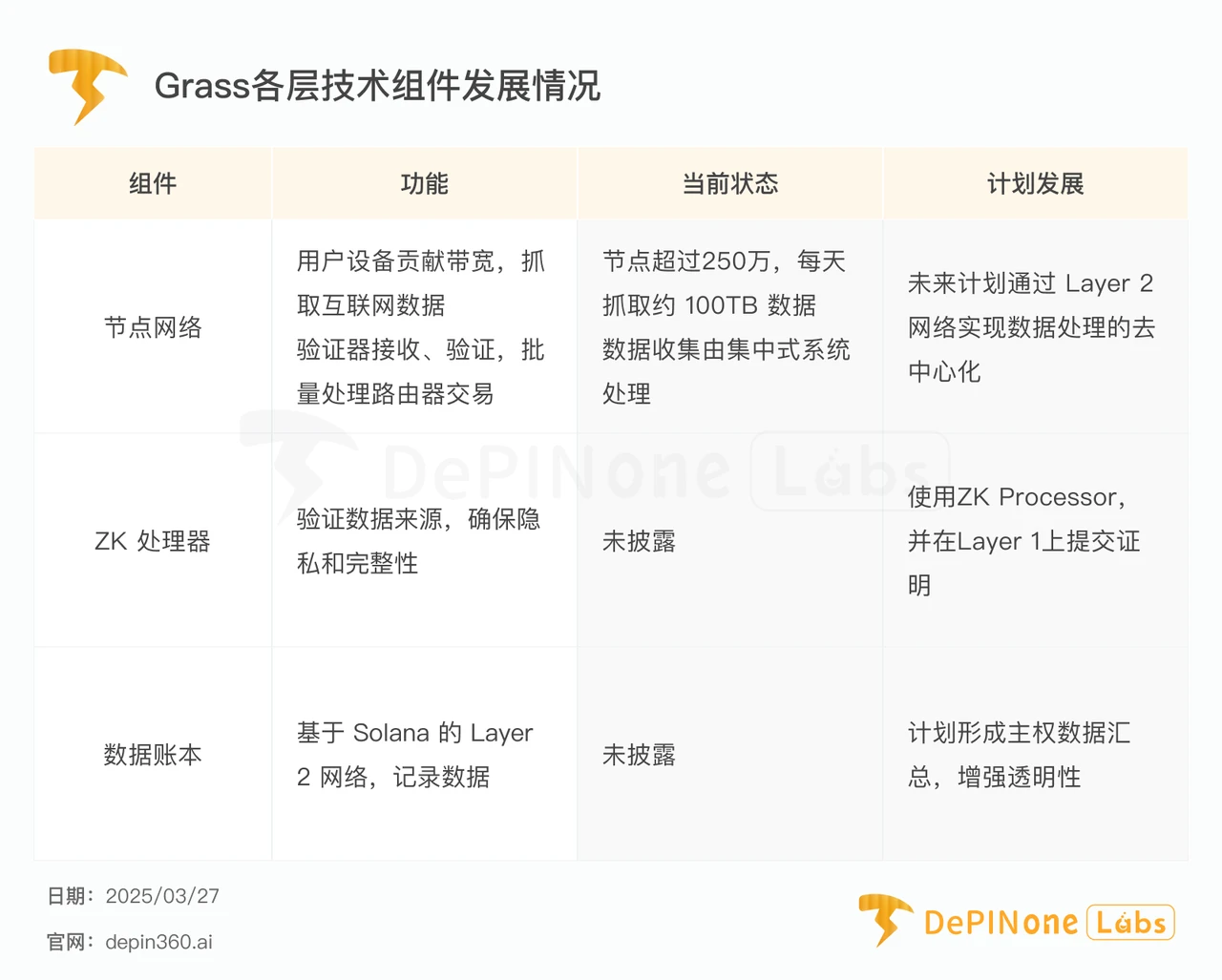
3.2 Technical Breakthroughs and Rationality
In the architecture disclosed by Grass, each layer has technical highlights.
Applying the DePIN concept to web data scraping fills the decentralized gap in AI data collection. This is the first large-scale application of DePIN in the data infrastructure field.
Using ZKP to verify data sources addresses privacy and trust issues of traditional centralized scraping, which is one of its technical highlights.
Building a Layer 2 network to handle high-throughput data transactions fully utilizes Solana's low-cost and high-efficiency advantages.
Additionally, Grass plans to launch "Live Context Retrieval" technology in the first quarter of 2025, which will further enhance its ability to provide real-time data for time-sensitive AI models.
Grass's technical design is not limited to single-layer highlights but forms a complete solution that supports its technical vision.
Grass's vision is to create a decentralized internet data layer that provides reliable and trustworthy data sources for AI development.
The scale of the node network can support the provision of diverse data sources, aligning with the principles of decentralization and democratization.
The privacy protection capabilities of ZKP ensure user data security, enhancing user trust.
The planned deployment of the Layer 2 network will improve network efficiency and scalability, supporting large-scale data processing needs.
However, it is still in the testing phase, with data collection handled by centralized systems, which may limit the realization of full decentralization. Future progress in the deployment of the Layer 2 network needs to be monitored to ensure the realization of the vision.
4. Business Model Flywheel
Grass presents an almost perfect business flywheel. The flywheel can move supply but cannot support demand.
Supply Side: 2.5 million nodes scrape 100TB of raw data daily, forming compliant datasets after ZK verification;
Demand Side: AI companies purchase data on demand, with revenues reinvesting into the ecosystem, completing the "bandwidth → data → cash flow" alchemy. (The demand side has yet to be validated — whether AI companies will pay for decentralized data remains to be proven by scaled orders.)
4.1 Business Model Closed Loop: Fully Utilizing Token Incentives
Grass's business model can be summarized as: users contribute bandwidth to earn Grass Points rewards → scrape public web data resources → AI companies purchase data → revenues form a closed loop through token distribution.
User Contribution of Bandwidth
Users share bandwidth by installing the extension/desktop application, recommending friends for a 20% direct reward and secondary and tertiary rewards of 10% and 5%, respectively.
Grass Points are calculated based on bandwidth usage, geographical location, and other factors, with plans to add rewards based on milestones and online time in the future.
Scraping Public Web Data Resources
Grass nodes utilize users' unused bandwidth and relay traffic so that the network can scrape public web data.
Grass's residential proxy network provides AI developers with diverse and geographically representative data sources.
AI Companies Purchase Data:
- AI companies purchase structured datasets through the Grass network for model training.
Revenue Closed Loop:
Network revenue is distributed to users through GRASS tokens, forming a sustainable incentive mechanism. Grass Points can be converted into GRASS tokens, with a total supply of 1 billion tokens, and 300 million tokens allocated for community distribution for future incentives and router rewards, ensuring long-term development.
Tokens can be staked to routers to support network traffic and earn rewards through network activity.
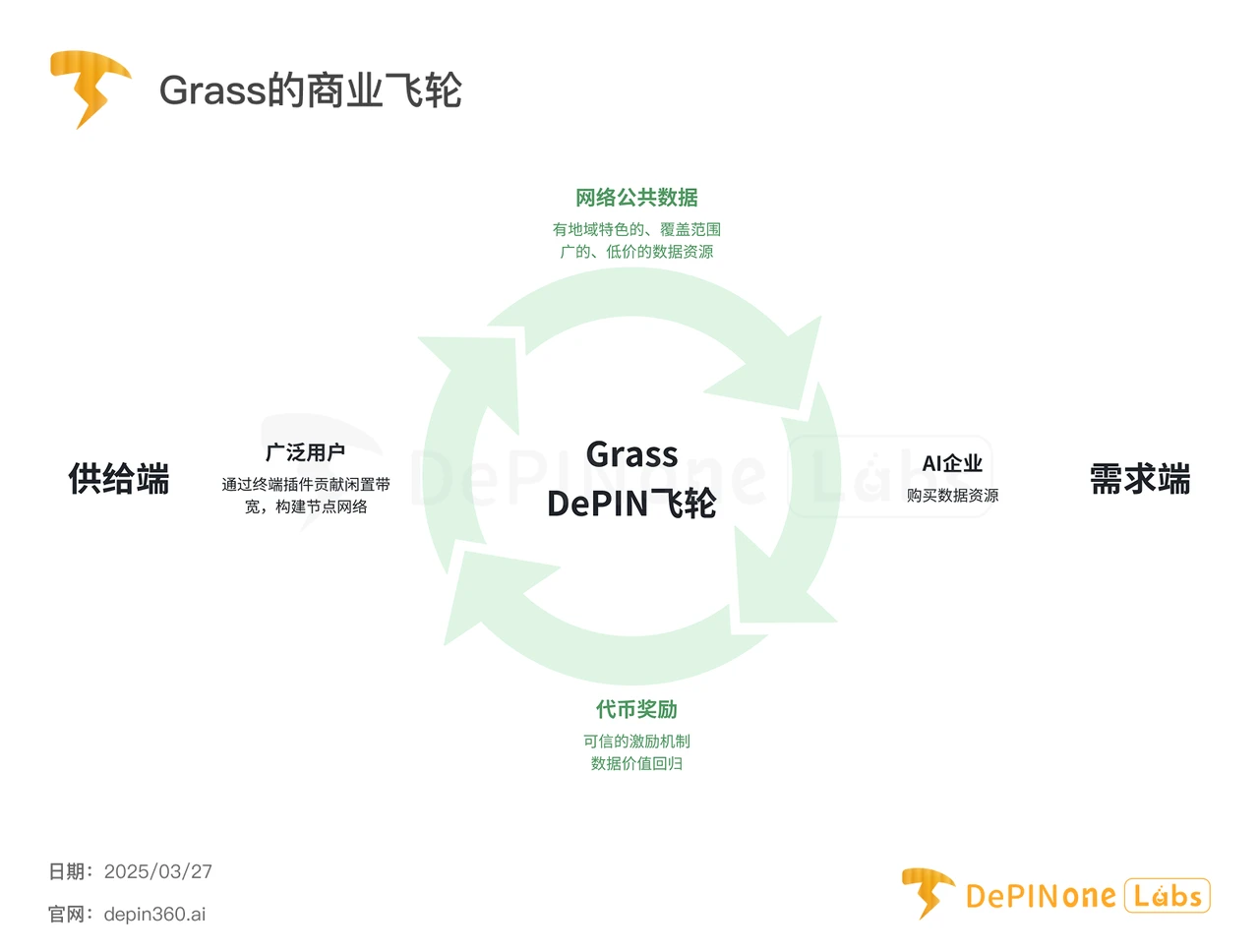
4.2 Model Innovation and Success
The biggest innovation in Grass's business model is the formation of a positive feedback loop through the referral system and token rewards. Of course, this is also a common feature of most DePIN projects.
Grass attempts to redistribute data value from large tech companies back to ordinary users. By applying the DePIN model to the AI data market, it creates passive income opportunities for users, disrupting the profit models of traditional centralized proxy networks (such as Luminati and Honeygain).
The success of its business model is closely tied to any of the following factors:
High user engagement: As of March 2025, there are over 2.5 million users, demonstrating ease of use and community appeal.
Market fit: The rapid growth in AI data demand fills the gap for a decentralized data layer, aligning with industry trends.
Economic incentives: Through token rewards and a referral system, a positive feedback loop is formed, attracting more user participation.
4.3 Flywheel Risks
Like the vast majority of DePIN projects, the weakness of the supply-demand business flywheel lies on the demand side.
The token incentive model has allowed the project to easily aggregate the supply side, but whether the massive amount of data can be effectively cleaned and processed to become a standard product that B-end clients are willing to pay for is still not evidenced by any official results.
In the design of the Grass project, they involve both the provision of AI datasets and the preparation of analysis. This allows AI companies (or businesses that find tracking media sentiment useful) that require extensive user text data to purchase it from users through Grass as an intermediary, rather than from large tech companies.
We look forward to seeing the realization of the demand side delivery in the future.
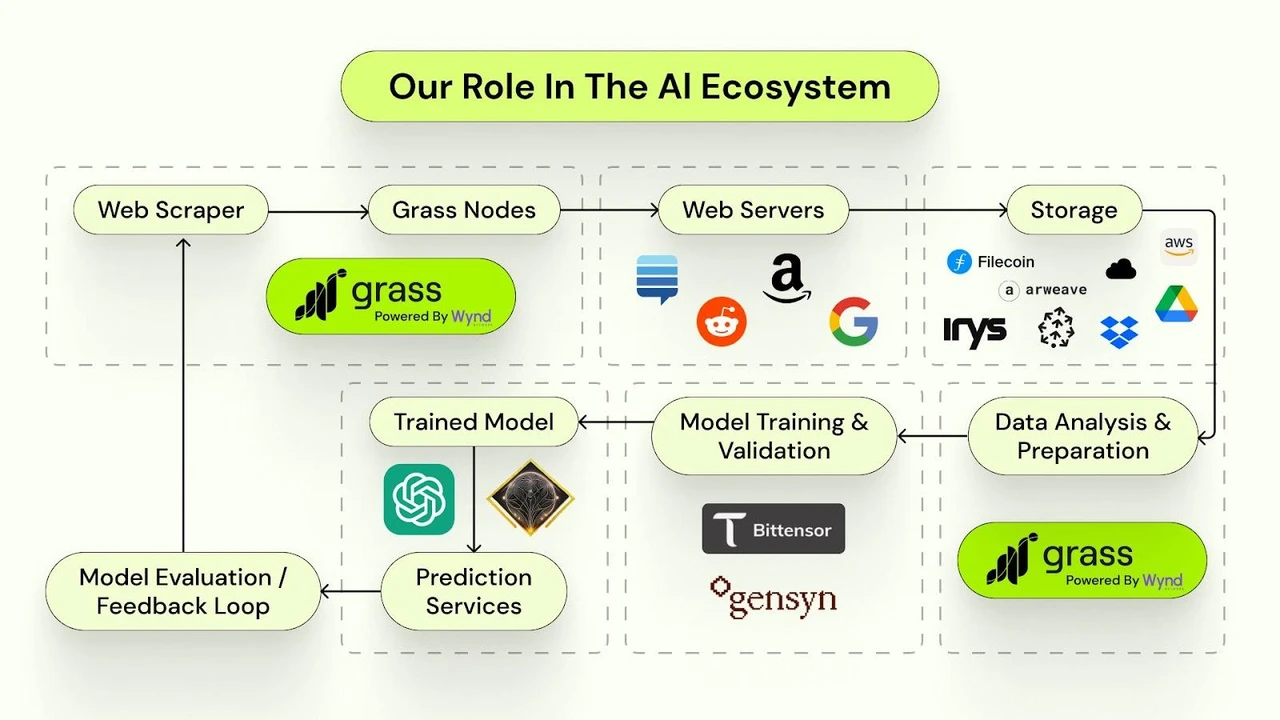
Another risk to note is that Grass's model provides users with the opportunity to share in the AI growth dividends, but attention must be paid to data privacy risks and the execution of the transition to decentralization.
5. Economic Model
When the capital feast recedes, are DePIN tokens truly hard currency for AI data, or just chips in a game of hot potato?
The surge in Grass's price is primarily attributed to a large user base, exchange listings, and the booming sentiment in the DePIN market, combined with operational user incentives and community participation rapidly expanding the user base.
However, attention should be paid to the impact of early investor unlocks and airdrop controversies, as well as whether demand-side validation can support long-term development.
5.1 Token Model
Grass's token economic model is based on its native token $GRASS, with a fixed total supply of 1 billion tokens.
According to its GitBook documentation, the token distribution is as follows:
Community: 30% (300 million tokens), including:
Future incentives: 170 million tokens, for retrospective plans to reward early contributors and developers creating valuable content or tools for the network.
Router rewards: 30 million tokens, to incentivize routers to support network traffic and reduce latency.
First airdrop: 100 million tokens (10% of total supply), distributed on October 28, 2024, rewarding over 2.5 million users.
Foundation and ecosystem growth: 22.8% (228 million tokens), held by the foundation to support network operations, upgrades, partnerships, and R&D.
Early investors: 25.2% (252 million tokens), with a 1-year lock-up period and a 1-year vesting period to ensure long-term commitment.
Team: 22% (220 million tokens), with a 1-year lock-up period and a 3-year vesting period to incentivize long-term team development.
Token uses include:
Rewards: Incentivizing users to contribute bandwidth and refer others.
Staking: Users can stake GRASS tokens to routers to support network traffic and earn rewards, with no minimum duration, but unstaking requires a 7-day lock-up period.
Governance: Token holders can participate in network decision-making, including voting on proposals and partner selections.
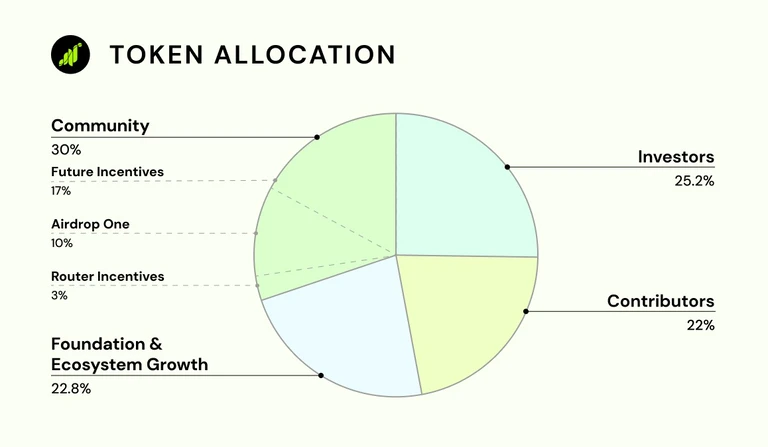
5.2 Token Market Analysis
The Grass project's token $GRASS was issued through the first airdrop on October 28, 2024, with an initial price of approximately $0.64.
Subsequently, the token price reached an all-time high of $3.90 on November 7, 2024, an increase of over 500%, primarily due to the airdrop attracting a large number of users and listings on major exchanges such as Bybit, Gate.io, and Bitget. Over the next two months, the price fluctuated between $2 and $4, remaining relatively stable.
At the beginning of 2025, the price saw a slight decline, followed by another wave of recovery in early March.
As of March 28, 2025, the price of the GRASS token was approximately $1.60, with a market capitalization of about $450 million and a 24-hour trading volume of $51.63 million (CoinMarketCap). The circulating supply was 243.905 million tokens, indicating that some tokens have yet to be unlocked.
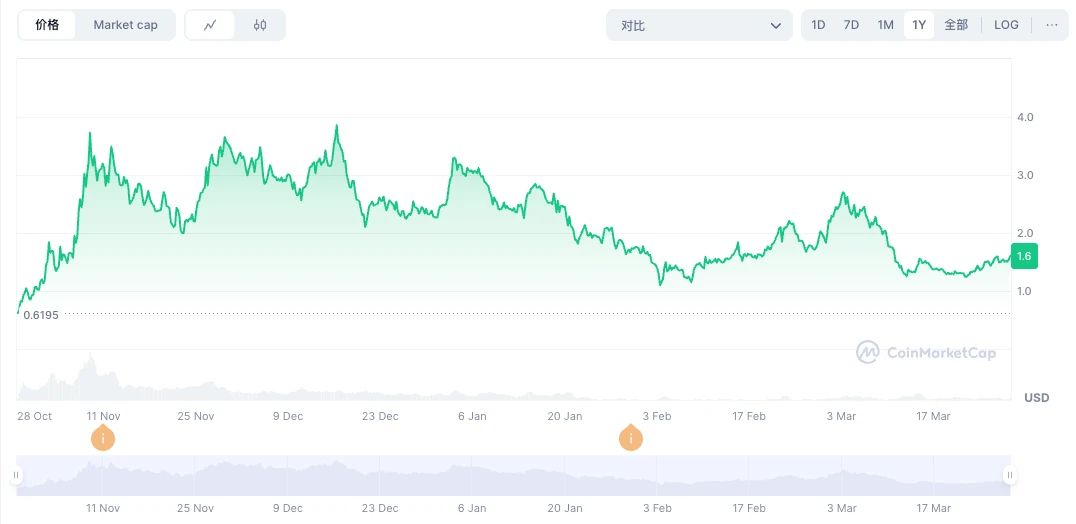
Compared to other projects launched during the same period, Grass's token price has undoubtedly performed remarkably well: it increased fivefold within 10 days of launch and maintained a relatively stable high price for six months.
Reasons for the Surge in Listing Price
Since the issuance of the GRASS token, particularly in October and November 2024, it has experienced significant early surges, peaking at $3.90 (CoinMarketCap). The main driving factors include:
A large user base: The first airdrop on October 28, 2024, distributed 100 million tokens, covering over 2.5 million users, greatly increasing market liquidity.
The first DePIN project token on the network: Compared to the high barriers to entry of traditional DePIN projects, Grass's network hanging project significantly lowered the participation threshold for users. Among this batch of projects, Grass was the first to conduct a TGE, breaking a long period without a DePIN project ICO.
Exchange listings: The token was listed on major exchanges such as Bybit, Gate.io, and Bitget, increasing trading volume and investor interest.
Industry market sentiment: The boom in DePIN and AI-related projects boosted investor confidence, especially in the fourth quarter of 2024. CryptoRank.io noted that the activity in the Solana ecosystem also contributed to the price increase.
Staking mechanism: Grass's staking mechanism offers users substantial returns. By the end of 2024, the total amount staked by users reached 27 million GRASS, accounting for 35% of the total supply. With an annualized return rate of 43.69%, which is significantly higher than the industry average APR, Grass has undoubtedly attracted the attention of many investors. As staking demand increases, the optimistic expectations for Grass's future growth become increasingly evident.
Operational Contributing Factors
Grass's operational strategy has also played a key role in maintaining price stability, with specific takeaways including:
User incentive mechanism: Rapidly expanding the user base through a referral system (20% direct rewards, 10% and 5% for secondary and tertiary referrals), exceeding 2.5 million users as of March 2025.
Community engagement: Active community activities and transparent progress updates have enhanced market confidence, such as continuously sharing milestones through X posts.
Technological advancements and market expectations: Plans to launch Android and iPhone mobile applications, as well as the deployment of Layer 2 networks, attract more investors. Bitget News mentioned that the announcement of the 2025 roadmap further propelled the price increase.
Development Risks
The current token price is driven by supply-side enthusiasm (low circulating supply + exchange listing effects), rather than genuine AI data procurement demand;
The high staking APY of up to 68% represents a false prosperity, essentially a hidden cost of token inflation;
47.2% of tokens are held by the team and early investors (220 million + 252 million), which will gradually unlock starting in 2025. If the demand side does not simultaneously explode, it may trigger selling pressure.
6. Project Ecosystem Analysis
Grass is in a leading position in the AI data and idle network-based DePIN projects, with clear competitive advantages.
The potential in the DePIN and AI data fields is significant, with ample room for industry growth; the Solana ecosystem supports its expansion.
6.1 Horizontal Comparison (Competitive Analysis)
According to incomplete statistics, there are currently over 600 projects in the DePIN industry, with a total market capitalization exceeding $16 billion. In the last three months of 2024, Grass consistently ranked first in Rootdata's DePIN project popularity list.
There are too many projects to list individually, so we will compare three representative projects: the market leader in the storage field, Filecoin; the market leader in wireless transmission, Helium; and Nodepay, which is closest to Grass's field and has also completed its TGE.
- Filecoin
Filecoin provides decentralized storage, allowing users to rent out unused storage space based on the Filecoin blockchain, using FIL tokens. As of March 5, 2025, there are approximately 1,500 active miners, with a market capitalization of about $2.5 billion.
- Helium
Helium is a decentralized wireless network primarily serving IoT devices, where users provide coverage by setting up hotspots and use HNT tokens. As of March 5, 2025, there are over 200,000 active hotspots, with a market capitalization of about $200 million.
- Nodepay
Nodepay is a network hanging platform where users can contribute bandwidth to support AI training and provide user feedback to earn NC tokens. Its market capitalization is approximately $10 million.
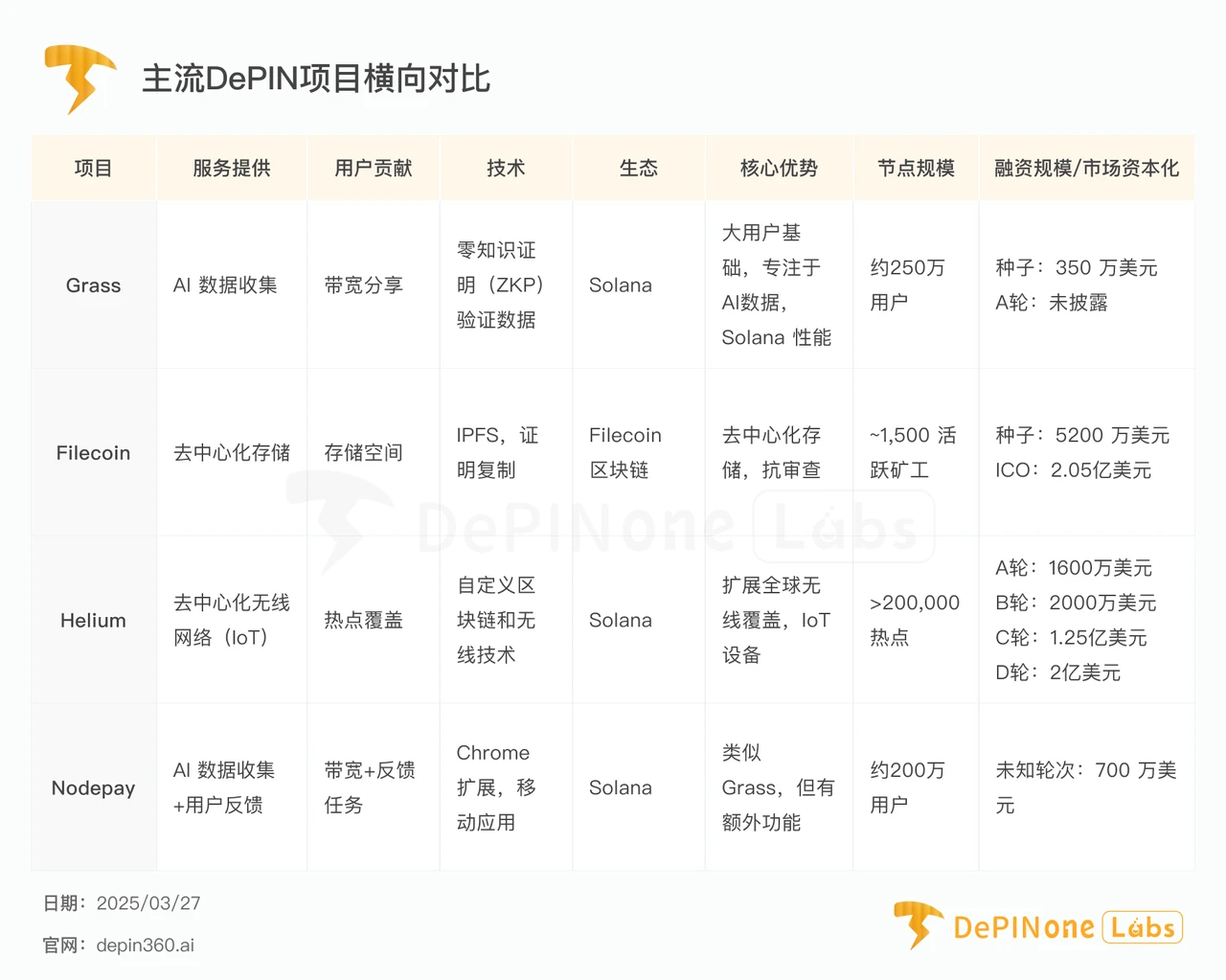
Service Offering: Both Grass and Nodepay focus on AI data collection, but Grass emphasizes bandwidth contribution, while Nodepay adds user feedback features; Filecoin provides storage services, and Helium offers wireless network coverage, showing clear differences in service areas.
User Contribution: Grass and Nodepay rely on bandwidth, Filecoin relies on storage space, and Helium relies on hotspot setups, with varying user participation methods.
Technology: Grass utilizes ZKP and Solana Layer 2, showcasing advanced technology; Filecoin uses IPFS and proof of replication, Helium employs a custom blockchain, while Nodepay has less disclosed technology.
Blockchain: Grass and Nodepay are based on Solana, which has strong scalability; Filecoin and Helium operate on their independent blockchains.
Core Advantages: Grass leads with a large user base and AI focus, Filecoin is resistant to censorship, Helium is suitable for IoT, and Nodepay offers diverse functions but has lower technological credibility.
6.2 Vertical Potential (Industry Space)
Growth Potential in the DePIN and AI Industries
The DePIN industry is rapidly growing, utilizing blockchain to manage physical infrastructure networks. According to HTX Research, there are 650 projects in 2023, with a total market capitalization of $35 billion, covering subfields such as storage, computing, and AI data collection.
Grass belongs to the AI subfield, with 83 AI-related projects according to DePIN Scan.
The demand in the AI data industry is immense, as model training requires high-quality, diverse data, while traditional methods face privacy and bias issues. Decentralized data collection offers a more secure and privacy-protecting data source, meeting the needs of AI development. Research indicates that the AI market is expected to reach trillions of dollars in the coming years, with continuous growth in data demand.
The combination of DePIN and AI creates a decentralized and secure data collection method, with Grass filling the gap in AI data infrastructure, capturing approximately 90TB of data daily, aligning with industry trends.
Scalability Supported by the Solana Ecosystem
Grass is based on the Solana network, known for its high performance and scalability, making it very suitable for DePIN applications. Solana's fast transaction speeds (thousands of transactions per second) and low fees support Grass in handling high-volume data transactions, enhancing its scalability potential.
The Solana ecosystem also has active communities and tools that support Grass's development and integration, with Layer 2 network plans further improving efficiency.
Currently, Solana is the main platform for DePIN activities. According to public data, there are approximately 78 DePIN projects on Solana (data referenced from platforms like Messari and DePIN Scan as of 2024), covering various subfields such as wireless communication (e.g., Helium), computing resources (e.g., Render Network), geolocation (e.g., Hivemapper), and cloud storage (e.g., GenesysGo SHDWDrive). Grass leads in this ecosystem with contributions from 2.5 million devices.
At this stage, Grass has secured its entry ticket to the AI data revolution, positioning itself as a proactive ecosystem builder. However, the Matthew effect in the DePIN track is becoming apparent, with giants gradually entering the market to replicate its model, prompting Grass to accelerate the establishment of data procurement protocol barriers.
7. Future Outlook
Grass is at the peak of the intersection of DePIN and AI, but the waves beneath may be more urgent than anticipated.
The common issue of weak demand on the demand side faced by DePIN projects is also occurring with Grass. The key question is whether it can translate an attractive business canvas into reality.
7.1 Project Development Roadmap
At the first founders' seminar in 2025, Grass outlined several key initiatives for the coming year.
The main highlights of the Grass 2025 roadmap include multi-modal search. Specifically, the platform plans to enable AI models to search for insights in real-time from video, audio, and text data semantically. Grass also plans to adopt new distribution methods to expand its reach through mobile and other platforms, simplifying user access and participation.
In addition, the platform will phase out the Chrome extension and introduce more powerful and efficient desktop nodes. Furthermore, it will introduce Horizontal Scaling, a new product that can further expand its capabilities, ensuring sustained growth and innovation.
Another key highlight is the results of Phase 1 of Sion. The Grass platform aims to enhance network efficiency, achieving a 60-fold increase in data retrieval speed.
"If you want to know — in the days following Phase 1 of Sion, network activity has dropped to nearly zero to give our storage partners time to catch up. No one anticipated this level of capability so early. Exciting times are ahead," said Andrej Radonjic, Grass's writer and co-founder of Wynd Network.
Based on Grass's current technological foundation, ecological layout, market performance, and the specific action plans already disclosed by the official team, we can summarize Grass's future development path into three main parts: technological iteration, ecological expansion, and governance upgrades.
Technological Iteration
Lightweight node network and mobile deployment: Plans to launch Android and iPhone mobile applications, allowing users to contribute idle bandwidth via their phones to expand the user base and participation. According to Bitget News, the mobile application is expected to complete testing and launch in the second half of 2025.
Data quality: The Grass 2025 roadmap includes the deployment of Sovereign Data Rollup, expected to be completed in the fourth quarter.
Transition to decentralization: Grass plans to complete the transition to full decentralization by the end of 2025, deploying a Solana-based Layer 2 network that uses zero-knowledge proofs (ZKP) to verify data, ensuring privacy and security. This will make data collection and verification more decentralized, enhancing the trust and reliability of the network.
Ecological Expansion
Dataset collaboration: Grass has partnered with Ontocord and LAION to create the VALID dataset, which will undergo further development. This multimodal collection, containing 30 million audio clips, images, and texts, serves as a foundation for AI model training and is an important resource for developers.
Partnerships: Grass plans to establish partnerships with AI companies and other stakeholders to expand the network's utility and adoption, attracting more data buyers.
Governance Upgrades
User incentive optimization: Grass will optimize its user incentive system, including adjustments to the calculation of Grass Points and the referral mechanism (20% direct rewards, 10% and 5% for secondary and tertiary referrals), to enhance user participation and retention.
Community engagement: The project will address past issues such as the initial airdrop distribution through transparent communication and community activities, rebuilding community trust and maintaining long-term development. (The initial airdrop caused dissatisfaction due to Phantom wallet issues, which need to be resolved through subsequent updates.)
In summary, Grass's future development path is clear, focusing on decentralization, user expansion, and technological upgrades, aligning with the growth trends in the DePIN and AI industries.
However, attention must be paid to the technical complexities of the transition to decentralization and the challenges of rebuilding community trust. If the above plans can be successfully executed, Grass is expected to maintain its leadership position in AI data infrastructure.
7.2 Risks and Challenges
Model Risks
Grass's business model collects data through user-contributed bandwidth and sells it to AI companies, with revenues used to reward users, forming a closed loop.
If the demand side (AI companies purchasing data) fails to materialize, Grass will not generate sufficient revenue to reward users, potentially leading to a loss of user participation motivation, a shrinking network scale, and subsequently affecting data collection capabilities, creating a vicious cycle that ultimately makes the model unsustainable.
Grass has not clarified how to price data; if priced too high, it may lose competitiveness; if priced too low, it may not cover operational costs.
If new data collection technologies (such as synthetic data) replace residential proxies, Grass may lose market share. According to EnterpriseAI.news, synthetic data is on the rise and may reduce the demand for real data.
Technical Risks
Complexity of the Transition to Decentralization
The transition from centralized to decentralized involves technical complexities and may face scalability, security, and performance issues. The deployment of Layer 2 networks must ensure high throughput and low latency; any technical failure could lead to network disruptions.
Research indicates that similar projects have experienced declines in user experience due to scalability issues during their transition to decentralization, and Grass must manage this carefully.
Data Quality and Integrity
In a decentralized network, data is collected by user devices, necessitating assurance of quality and integrity. Any data bias or malicious activity could undermine the trust of AI developers. Data quality is a core challenge for all DePIN projects.
The implementation of ZKP must ensure data source traceability but may face efficiency issues that affect processing speed.
ZKP Efficiency and Cost
- The efficiency of zero-knowledge proofs directly impacts network performance. Research shows that ZKP may increase computational costs in high data volume scenarios, and Grass needs to optimize ZKP to balance privacy and performance.
Market Risks
Competitive Pressure
Grass faces competition from centralized data providers (such as Luminati) and decentralized competitors (such as Nodepay). Alternative projects may offer lower costs or richer features, attracting AI developers.
Continuous innovation is necessary to maintain market leadership.
Regulatory Compliance Challenges
Data privacy regulations (such as GDPR) may impose higher requirements on decentralized data collection, and regulatory changes could increase operational costs or restrict certain activities.
Research indicates that DePIN projects need to adapt to the regulatory environments of different jurisdictions, and Grass may face compliance pressures.
Community Trust Rebuilding
The initial airdrop distribution caused community dissatisfaction due to issues with the Phantom wallet, necessitating the rebuilding of trust to maintain user participation.
Any further mismanagement of the community could lead to user attrition, impacting long-term development.
Token Economic Management
The current token price is driven by supply-side enthusiasm (low circulation + exchange listing effect), rather than genuine AI data procurement demand.
The total supply of GRASS tokens is 1 billion, requiring managed distribution to avoid market volatility. Unlocking for early investors and the team may lead to price pressure, necessitating a balance between user incentives and market stability.
7.3 Summary
Grass demonstrates significant potential in the DePIN and AI data fields, leveraging technological innovation, market positioning, and a large user base to gain an advantage, making it suitable for investors focused on DePIN and AI trends. Continuing to participate in Grass at this stage with a low barrier to entry remains a good choice.
However, its technological implementation and market competition risks require close attention. Key areas to focus on include the realization of the technical vision for decentralization, verification of actual transactions on the demand side, and sustained user growth following the launch of the mobile application; these are all important milestones in the future development journey. If the aforementioned issues can be addressed one by one, the long-term value of Grass remains promising.
Special Statement: All articles from DePINone Labs are for informational and educational purposes only and do not constitute any investment advice.
References
Gitbook of Grass https://grass-foundation.gitbook.io/grass-docs/introduction
DePIN’s Imperfect Present & Promising Future: A Deep Dive https://www.compound.vc/writing/depin (to be reprinted and interpreted later)
Reshaping the data layer of AI with Grass https://blockworks.co/news/depin-grass-reshaping-ai-data-layer
Grass DePIN Protocol Review: Data for AI and Monetization of Internet Connectivity https://medium.com/@alexanderallenme/grass-depin-protocol-review-data-for-ai-and-monetization-of-internet-connectivity-6b616f799134
Grass Unveils 2025 Roadmap: What You Need To Know https://www.bitget.com/news/detail/12560604497754
For AI that serves people, data curation DePINs hold the key | Opinion https://crypto.news/ai-that-serves-people-data-curation-depins-hold-key/
Special Statement: All articles from DePINone Labs are for informational and educational purposes only and do not constitute any investment advice.
This report is produced by DePINone Labs; for reprints, please contact us.
免责声明:本文章仅代表作者个人观点,不代表本平台的立场和观点。本文章仅供信息分享,不构成对任何人的任何投资建议。用户与作者之间的任何争议,与本平台无关。如网页中刊载的文章或图片涉及侵权,请提供相关的权利证明和身份证明发送邮件到support@aicoin.com,本平台相关工作人员将会进行核查。




